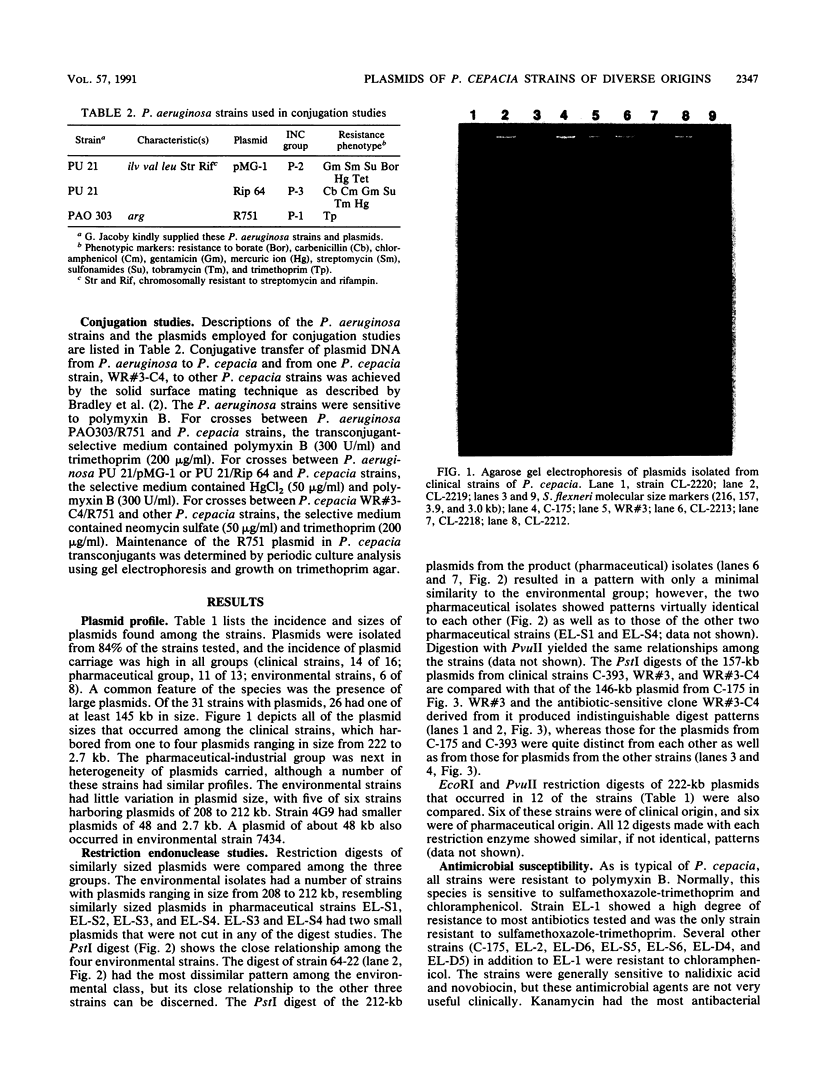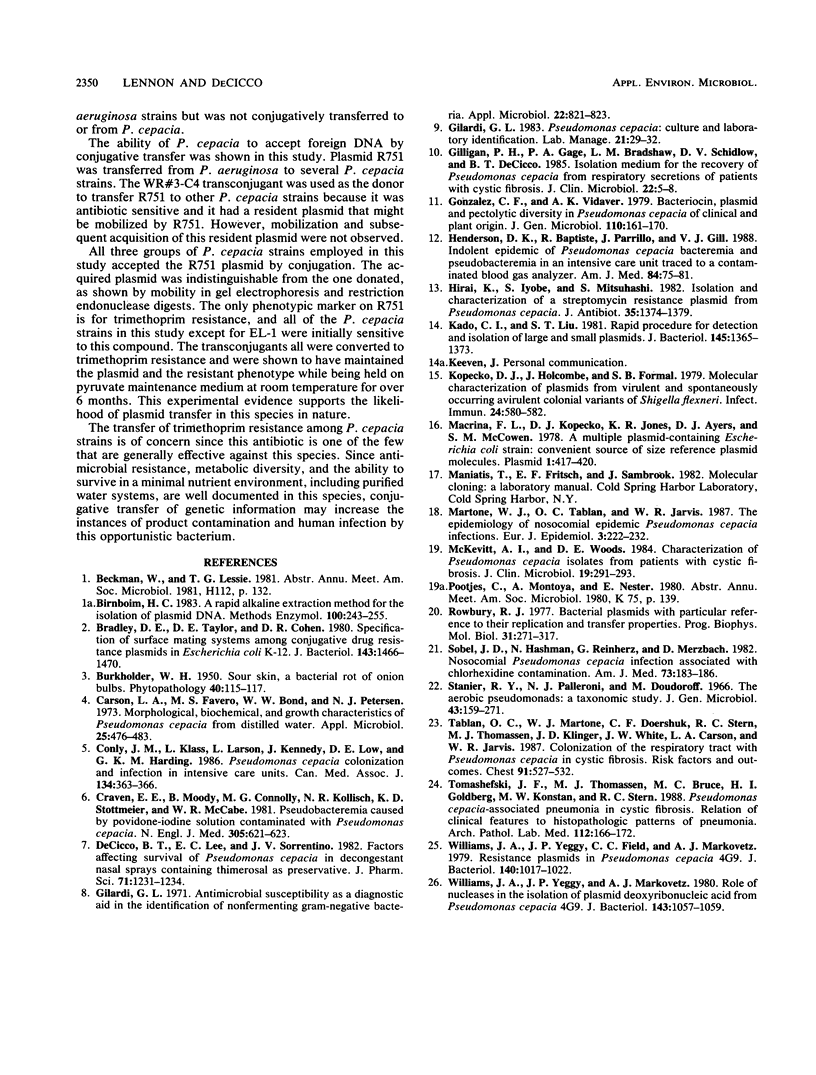Abstract
Thirty-seven strains of Pseudomonas cepacia from clinical, pharmaceutical-industrial, and environmental origins were analyzed for the presence of plasmid DNA by a modification of the rapid alkaline extraction method of Birnboim (H. C. Birnboim, Methods Enzymol. 100:243-255, 1983). Plasmids were present in 31 strains (84%) from all sources, with no one source showing less than 75% plasmid carriage among its strains. The plasmid profiles indicated that the presence of large plasmids (146 to 222 kb) was the norm. Those strains with greater antibiotic resistance were mainly in the clinical and pharmaceutical groups and carried large plasmids (222 kb) that appeared essentially identical by restriction digest analysis. The ability for conjugative transfer was shown with the broad-host-range plasmid R751 carrying the gene for resistance to trimethoprim, one of the few antimicrobial agents effective against P. cepacia. The plasmid was transferred from Pseudomonas aeruginosa to P. cepacia strains as well as from P. cepacia transconjugants to other P. cepacia strains.
Full text
PDF





Images in this article
Selected References
These references are in PubMed. This may not be the complete list of references from this article.
- Birnboim H. C. A rapid alkaline extraction method for the isolation of plasmid DNA. Methods Enzymol. 1983;100:243–255. doi: 10.1016/0076-6879(83)00059-2. [DOI] [PubMed] [Google Scholar]
- Bradley D. E., Taylor D. E., Cohen D. R. Specification of surface mating systems among conjugative drug resistance plasmids in Escherichia coli K-12. J Bacteriol. 1980 Sep;143(3):1466–1470. doi: 10.1128/jb.143.3.1466-1470.1980. [DOI] [PMC free article] [PubMed] [Google Scholar]
- Carson L. A., Favero M. S., Bond W. W., Petersen N. J. Morphological, biochemical, and growth characteristics of pseudomonas cepacia from distilled water. Appl Microbiol. 1973 Mar;25(3):476–483. doi: 10.1128/am.25.3.476-483.1973. [DOI] [PMC free article] [PubMed] [Google Scholar]
- Conly J. M., Klass L., Larson L., Kennedy J., Low D. E., Harding G. K. Pseudomonas cepacia colonization and infection in intensive care units. CMAJ. 1986 Feb 15;134(4):363–366. [PMC free article] [PubMed] [Google Scholar]
- Craven D. E., Moody B., Connolly M. G., Kollisch N. R., Stottmeier K. D., McCabe W. R. Pseudobacteremia caused by povidone-iodine solution contaminated with Pseudomonas cepacia. N Engl J Med. 1981 Sep 10;305(11):621–623. doi: 10.1056/NEJM198109103051106. [DOI] [PubMed] [Google Scholar]
- Decicco B. T., Lee E. C., Sorrentino J. V. Factors affecting survival of Pseudomonas cepacia in decongestant nasal sprays containing thimerosal as preservative. J Pharm Sci. 1982 Nov;71(11):1231–1234. doi: 10.1002/jps.2600711112. [DOI] [PubMed] [Google Scholar]
- Gilardi G. L. Antimicrobial susceptibility as a diagnostic aid in the identification of nonfermenting gram-negative bacteria. Appl Microbiol. 1971 Nov;22(5):821–823. doi: 10.1128/am.22.5.821-823.1971. [DOI] [PMC free article] [PubMed] [Google Scholar]
- Gilligan P. H., Gage P. A., Bradshaw L. M., Schidlow D. V., DeCicco B. T. Isolation medium for the recovery of Pseudomonas cepacia from respiratory secretions of patients with cystic fibrosis. J Clin Microbiol. 1985 Jul;22(1):5–8. doi: 10.1128/jcm.22.1.5-8.1985. [DOI] [PMC free article] [PubMed] [Google Scholar]
- Gonzalez C. F., Vidaver A. K. Bacteriocin, plasmid and pectolytic diversity in Pseudomonas cepacia of clinical and plant origin. J Gen Microbiol. 1979 Jan;110(1):161–170. doi: 10.1099/00221287-110-1-161. [DOI] [PubMed] [Google Scholar]
- Henderson D. K., Baptiste R., Parrillo J., Gill V. J. Indolent epidemic of Pseudomonas cepacia bacteremia and pseudobacteremia in an intensive care unit traced to a contaminated blood gas analyzer. Am J Med. 1988 Jan;84(1):75–81. doi: 10.1016/0002-9343(88)90011-3. [DOI] [PubMed] [Google Scholar]
- Hirai K., Iyobe S., Mitsuhashi S. Isolation and characterization of a streptomycin resistance plasmid from Pseudomonas cepacia. J Antibiot (Tokyo) 1982 Oct;35(10):1374–1379. doi: 10.7164/antibiotics.35.1374. [DOI] [PubMed] [Google Scholar]
- Kado C. I., Liu S. T. Rapid procedure for detection and isolation of large and small plasmids. J Bacteriol. 1981 Mar;145(3):1365–1373. doi: 10.1128/jb.145.3.1365-1373.1981. [DOI] [PMC free article] [PubMed] [Google Scholar]
- Kopecko D. J., Holcombe J., Formal S. B. Molecular characterization of plasmids from virulent and spontaneously occurring avirulent colonial variants of Shigella flexneri. Infect Immun. 1979 May;24(2):580–582. doi: 10.1128/iai.24.2.580-582.1979. [DOI] [PMC free article] [PubMed] [Google Scholar]
- Macrina F. L., Kopecko D. J., Jones K. R., Ayers D. J., McCowen S. M. A multiple plasmid-containing Escherichia coli strain: convenient source of size reference plasmid molecules. Plasmid. 1978 Jun;1(3):417–420. doi: 10.1016/0147-619x(78)90056-2. [DOI] [PubMed] [Google Scholar]
- Martone W. J., Tablan O. C., Jarvis W. R. The epidemiology of nosocomial epidemic Pseudomonas cepacia infections. Eur J Epidemiol. 1987 Sep;3(3):222–232. doi: 10.1007/BF00149728. [DOI] [PubMed] [Google Scholar]
- McKevitt A. I., Woods D. E. Characterization of Pseudomonas cepacia isolates from patients with cystic fibrosis. J Clin Microbiol. 1984 Feb;19(2):291–293. doi: 10.1128/jcm.19.2.291-293.1984. [DOI] [PMC free article] [PubMed] [Google Scholar]
- Rowbury R. J. Bacterial plasmids with particular reference to their replication and transfer properties. Prog Biophys Mol Biol. 1977;31(3):271–317. doi: 10.1016/0079-6107(78)90011-1. [DOI] [PubMed] [Google Scholar]
- Sobel J. D., Hashman N., Reinherz G., Merzbach D. Nosocomial Pseudomonas cepacia infection associated with chlorhexidine contamination. Am J Med. 1982 Aug;73(2):183–186. doi: 10.1016/0002-9343(82)90176-0. [DOI] [PubMed] [Google Scholar]
- Stanier R. Y., Palleroni N. J., Doudoroff M. The aerobic pseudomonads: a taxonomic study. J Gen Microbiol. 1966 May;43(2):159–271. doi: 10.1099/00221287-43-2-159. [DOI] [PubMed] [Google Scholar]
- Tablan O. C., Martone W. J., Doershuk C. F., Stern R. C., Thomassen M. J., Klinger J. D., White J. W., Carson L. A., Jarvis W. R. Colonization of the respiratory tract with Pseudomonas cepacia in cystic fibrosis. Risk factors and outcomes. Chest. 1987 Apr;91(4):527–532. doi: 10.1378/chest.91.4.527. [DOI] [PubMed] [Google Scholar]
- Tomashefski J. F., Thomassen M. J., Bruce M. C., Goldberg H. I., Konstan M. W., Stern R. C. Pseudomonas cepacia-associated pneumonia in cystic fibrosis. Relation of clinical features to histopathologic patterns of pneumonia. Arch Pathol Lab Med. 1988 Feb;112(2):166–172. [PubMed] [Google Scholar]
- Williams J. A., Yeggy J. P., Field C. C., Markovetz A. J. Resistance plasmids in Pseudomonas cepacia 4G9. J Bacteriol. 1979 Dec;140(3):1017–1022. doi: 10.1128/jb.140.3.1017-1022.1979. [DOI] [PMC free article] [PubMed] [Google Scholar]
- Williams J. A., Yeggy J. P., Markovetz A. J. Role of nucleases in the isolation of plasmid deoxyribonucleic acid from Pseudomonas cepacia 4G9. J Bacteriol. 1980 Aug;143(2):1057–1059. doi: 10.1128/jb.143.2.1057-1059.1980. [DOI] [PMC free article] [PubMed] [Google Scholar]






